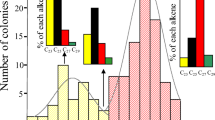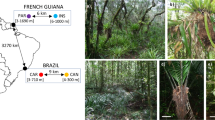Abstract
We studied the effect of nestmate separation on trophallaxis in the polydomous ant Cataglyphis iberica. After dividing three colonies into two equivalent subgroups, one queenright and one queenless, we quantified the frequency of trophallaxis within each subgroup, between the workers from the two subgroups (“mixed” trophallaxis), and trophallaxis involving the queen. Observations of trophallaxis were conducted over four periods of time: for 2 weeks before the separation of the two subgroups, 8 weeks during separation, immediately after reunification, and 3 weeks following reunification. Subgroups were identically fed on the eve of each day of observation. Group separation induced an increase in “mixed” frequencies of trophallaxis just after reunification, after which trophallaxis returned to the initial level observed before separation. Previous results showed that group separation in C. iberica induces hydrocarbon profile divergence and that reunification restores this chemical modification. The current results seem to indicate that increased trophallaxis permits a uniform odor to be reestablished among previously separated ants. Trophallaxis involving the queen is infrequent and does not seem to be crucial in the process of odor exchange. Our data confirm that trophallaxis plays a key role in establishing the “Gestalt” colony odor, particularly among naturally separated satellite nests in a polydomous species like C. iberica.
Similar content being viewed by others
REFERENCES
Berton, F., Lenoir, A., Nowbahari, E., and Barreau, S. (1991). Ontogeny of queen attraction to workers in the ant Cataglyphis cursor (Hym. Formicidae). Insectes Soc. 38: 293–305.
Bonavita-Cougourdan, A. (1983). Activité antennaire et flux trophallactique chez la fourmi Camponotus vagus Scop. (Hym. Form.). Insectes Soc. 30: 423–442.
Boulay, R., Quagebeur, M., Godziñska, E. J., and Lenoir, A. (1999). Social isolation in ants: Evidence of its impact on survivorship and behavior in Camponotus fellah (Hymenoptera, Formicidae). Sociobiology 33: 111–124.
Cerdá, X., Retana, J., and De Haro, A. (1994). Social carrying between nests in polycalic colonies of the monogynous ant Catalyphis iberica (Hymenoptera: Formicidae). Sociobiology 23: 215–231.
Crozier, R. H., and Dix, M. W. (1979). Analysis of two genetic models for the innate components of colony odour in social Hymenoptera. Behav. Ecol. Sociobiol. 4: 217–224.
Dahbi, A., and Lenoir, A. (1998a). Nest separation and the dynamics of the “Gestalt” odour in the polydomous ant Cataglyphis iberica (Hymenoptera, Formicidae). Behav. Ecol. Sociobiol. 42: 349–355.
Dahbi, A., and Lenoir, A. (1998b). Queen and colony odour in the multiple nest ant species, Cataglyphis iberica (Hymenoptera, Formicidae). Insectes Soc. 45: 301–313.
Dahbi, A., Cerdá, X., Hefetz, A., and Lenoir, A. (1996). Social closure, aggressive behavior and cuticular hydrocarbon profile in the polydomous ant Cataglyphis iberica (Hymenoptera, Formicidae). J. Chem. Ecol. 22: 2173–2186.
Dahbi, A., Cerdá, X., Hefetz, A., and Lenoir, A. (1997). Adult transport in the ant Cataglyphis iberica: A means to maintain a uniform colonial odour in a species with multiple nests. Physiol. Entomol. 22: 13–19.
DeVroey, S. C., and Pasteels, J. M. (1978). Agonistic behaviour of Myrmica rubra L. Insectes Soc. 25: 247–265.
Hölldobler, B., and Wilson, E. O. (1990). The Ants, Springer-Verlag, Heidelberg, Berlin.
Lahav, S., Soroker, V., Vander Meer, R. K., and Hefetz, A. (1998). Nestmate recognition in the ant Cataglyphis niger: Do queens matter? Behav. Ecol. Sociobiol. 43: 203–212.
Lahav, S., Soroker, V., Hefetz, A., and Vander Meer, R. K. (1999). Direct behavioral evidence for hydrocarbons as ant recognition discriminators. Naturwissenchaften 86: 246–249.
Lenoir, A., and Jaisson, P. (1982). Evolution et rôle des communications antennaires chez les insectes sociaux. In Jaisson, P. (ed.), Social Insects in the Tropics, Vol. 1, Université Paris-Nord Press, Paris, pp. 157–180.
Lenoir, A., Fresneau, D., Errard, C., and Hefetz, A. (1999). Individuality and colonial identity in ants: The emergence of the social representation concept. In Detrain, C., Deneubourg, J. L., and Pasteels, J. (eds.). Information Processing in Social Insects, Birkhäuser, Basel (in press).
Liebig, J., Heinze, J., and Hölldobler, B. (1997). Trophallaxis and aggression in the ponerine ant, Ponera coarctata: Implications for the evolution of liquid food exchange in the Hymenoptera. Ethology 103: 707–722.
Meskali, M., Bonavita-Cougourdan, A., Provost, E., Bagnères, A.-G., Dusticier, G., and Clément, J.-L. (1995). Mechanism underlying cuticular hydrocarbon homogeneity in the ant Camponotus vagus (Scop.) (Hymenoptera: Formicidae): Role of postpharyngeal glands. J. Chem. Ecol. 21: 1127–1148.
Naumann, K., Winston, M. L., and Slessor, K. N. (1993). Movement of honey bee (Apis mellifera L.) queen mandibular gland pheromone in populous and unpopulous colonies. J. Insect Behav. 6: 211–223.
Provost, E. (1989). Social environmental factors influencing mutual recognition of individuals in the ant Leptothorax lichtensteini Bondr. (Hymenoptera: Formicidae). Behav. Process. 18: 35–59.
Soroker, V., Vienne, C., Nowbahari, E., and Hefetz, A. (1994). The postpharyngeal gland as a Gestalt organ for nestmate recognition in the ant Cataglyphis niger. Naturwissenschaften 81: 510–513.
Soroker, V., Vienne, C., and Hefetz, A. (1995). Hydrocarbon dynamics within and between nestmates in Cataglyphis niger (Hymenoptera: Formicidae). J. Chem. Ecol. 21: 365–378.
Soroker, V., Fresneau, D., and Hefetz, A. (1998). The formation of colony odor in the ponerine ant Pachycondyla apicalis (Formicidae: Ponerinae). J. Chem. Ecol. 24: 1077–1090.
Vander Meer, R. K., and Morel, L. (1998). Nestmate recognition in ants. In Vander Meer, R. K., Breed, M. D., Winston, M., and Espelie, C. (eds.), Pheromone Communication in Social Insects: Ants, Wasps, Bees, and Termites, Westview Press, Boulder, CO, pp. 79–103.
Vienne, C., Soroker, V., and Hefetz, A. (1995). Congruency of hydrocarbon patterns in heterospecific groups of ants: Transfer and/or biosynthesis? Insectes Soc. 42: 267–277.
Author information
Authors and Affiliations
Rights and permissions
About this article
Cite this article
Dahbi, A., Hefetz, A., Cerdá, X. et al. Trophallaxis Mediates Uniformity of Colony Odor in Cataglyphis iberica Ants (Hymenoptera, Formicidae). Journal of Insect Behavior 12, 559–567 (1999). https://doi.org/10.1023/A:1020975009450
Issue Date:
DOI: https://doi.org/10.1023/A:1020975009450




